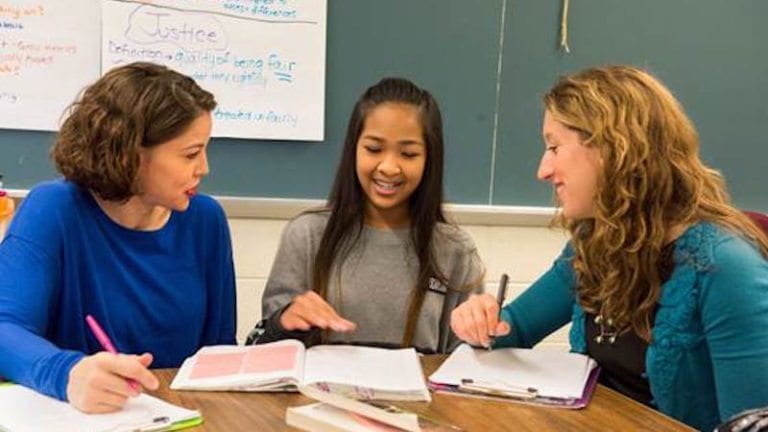A workshop is a physical location where a craftsperson makes something. A reader is a person who reads. So what’s a reader’s workshop? It’s a place where a reader makes meaning from the words on a page. It sounds easy enough, but it takes knowledge, planning, and consistency to make it work. Here are 20 teachers and readers who are making meaning through their reading each and every day.
1. Read high quality books from people who’ve been there and done it well
When kids are sitting around reading in your classroom, it’s good to be able to talk to anyone about what they’re doing and why. Use good professional development books to help you build your rationale.
https://www.instagram.com/p/BXa-Su8nEF9/
2. Look around at other teachers for inspiration
Sometimes it’s hard to get new ideas when we can never leave our classroom. So look around at what works at your school and check out teacher blogs for ideas.
https://www.instagram.com/p/BY3qH0khXTV/
3. Create an easy-to-reach, attractive place for kids to keep their reader’s workshop tools
Some people are going to make things more attractive, others prefer the minimalist route. All reader’s workshops are organized.
https://www.instagram.com/p/BWwK8TwDry9/
4. Give students ideas for how to track their thinking.
When students learn many different ways to keep track of what they think, they will use the one that works for them.
https://www.instagram.com/p/BM91Jy8j7mu/
5. Start reader’s workshop as early as pre-reading
Pre-schoolers and kindergarteners can make excellent use of reader’s workshop time. This helps develop healthy reading habits that last a lifetime.
https://www.instagram.com/p/BZCoBioFk4o/
6. Design social reading opportunities
Readers who learn to make meaning of the words they read can’t wait to share their thinking with others.
https://www.instagram.com/p/BZM7jokB83H/
7. Practice doing the work of reading.
Don’t expect students to know how to read for long periods of time. Building up stamina takes time but the payoff is worth it.
https://www.instagram.com/p/BY1mq8zHozO/
8. Model and discuss what reader’s workshop feels like
Talking about what to expect reader’s workshop will sounds like, look like, and feel like leaves students understanding when it’s working and when it isn’t.
https://www.instagram.com/p/BYwlaHFHiO9/
9. Build excitement about books, libraries, and reading.
Dangle reading like a carrot on a stick. Tell them you let them read when you think they’ll really appreciate it. If no one has ever told kids that reading is thrilling, how will they know it is?
https://www.instagram.com/p/BYer7OeDR6n/
10. Develop ways to help children find the information they need
They might not all use it well, but they’ll know where to find it when they really need it. They might even remember the system and use it after they’ve left your classroom.
https://www.instagram.com/p/BYeCE0tgn1C/
11. Tell them what you’re reading
Don’t assume they know you read. Share the books you read with them and talk about your reading life.
https://www.instagram.com/p/BYW5PxclaOB/
12. Lead them to the books
The old saying goes, “you can lead them to water, but you can’t make them drink.” Make sure they know how to get to the books they love, so that they can read whenever they want.
https://www.instagram.com/p/BX5RLOIFJoh/
13. Expand their knowledge of genres
Let them read what they love, but introduce them to all genres. It’s important to know what’s out there and kids don’t always know what they might love.
https://www.instagram.com/p/BVcrSBeFgYm/
14. Make art that represents the books they read
Using every sense in our learning helps readers make more meaning from the words they read.
https://www.instagram.com/p/BVX5UkBBkTL/
15. Ask them to share their reading lives
Teaching kids to share what books they loved and why helps them see that reading has a purpose.
https://www.instagram.com/p/BVGLGmbgxzx/
16. Dive in deep
Asking kids to develop and share their thoughts about the books they read gives them the confidence to do it on their own.
https://www.instagram.com/p/BVGLGmbgxzx/
17. Think carefully about what you want them to learn
Don’t fly by the seat of your pants. Have a plan and carry it out. Every child deserves to know what skill to work on next.
https://www.instagram.com/p/BTzedoIAxIj/
18. Connect their reading to their lives
Help readers see how the characters they are reading about learn lessons just like they do. The more students see themselves in the books they read, the better choices they will make in the future.
https://www.instagram.com/p/BT0Aw_ilWM8/
19. Know your books
The best way to get kids to read many and varied books is to book talk. You can’t talk about books if you don’t know they’re out there.
https://www.instagram.com/p/BZJYYNBlNHs/
20. Respect reading time
Don’t let anything come between reading time and your kids. When they know you put reading first, they will too.
https://www.instagram.com/p/BY9SAMInwhe/
How do you do reader’s workshop in the classroom? We’d love to hear your ideas in the comments.


